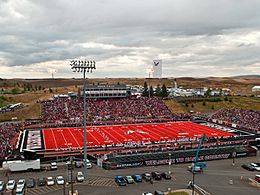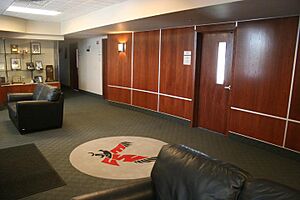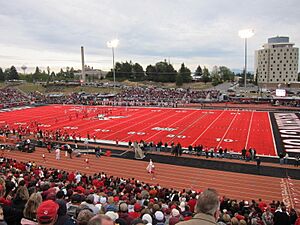Roos Field facts for kids
|
"The Inferno"
|
|

Debut of red field in 2010
|
|
| Lua error in Module:Location_map at line 420: attempt to index field 'wikibase' (a nil value). | |
| Former names | Woodward Field (1967–2009) |
|---|---|
| Location | Eastern Washington University Cheney, Washington, U.S. |
| Elevation | 2,470 feet (755 m) AMSL |
| Owner | Eastern Washington University |
| Operator | Eastern Washington University |
| Capacity | 8,600 (2004–present) 7,500 (1967–2003) |
| Record attendance | 11,702 (September 18, 2010) |
| Surface | AstroTurf 3D3 (red) (2020–) SprinTurf (red) (2010–2020) Natural grass (1967–2009) |
| Construction | |
| Broke ground | 1966 |
| Opened | 1967, 59 years ago |
| Construction cost | $1.5 million ($13.2 million in 2022 ) |
| Architect | T.W. Clark Construction LLC |
| Tenants | |
| Eastern Washington Eagles (1967–present) | |
Roos Field is an exciting outdoor college football stadium located in Cheney, Washington. It's home to the Eastern Washington Eagles, who play in the Big Sky Conference. This stadium is famous for its bright red playing field, which makes it stand out!
The stadium first opened in 1967. Since then, the Eagles have had a great record playing at home. In 2004, the stadium grew bigger. Its seating capacity increased to 8,700 permanent seats. Sometimes, extra temporary seats are added for big games, allowing almost 12,000 fans to cheer on the team!
Contents
What's in a Name? The History of Roos Field
The stadium was first called Woodward Field. This name honored Arthur C. Woodward, who was a coach for both the Eagles' football and basketball teams. The original Woodward Field was in a different spot, near the university's library today.
The stadium got its new name, Roos Field, before the 2010 football season. It was renamed to honor Michael Roos. Michael Roos was a fantastic NFL player and used to play football for Eastern Washington. He also gave a lot of money to help pay for the special red turf field.
Big Changes: The 2004 Renovation
Roos Field got a major makeover in 2004. This renovation made many parts of the stadium better. Public areas were improved, and a brand-new press box was built. The team also got updated locker rooms.
The renovation happened in different stages. The first stage, completed in 2002, improved the stadium's entrance and ticket office. The second stage added new suites and a media center. These new areas replaced an older, smaller press box. The third stage increased the number of permanent seats from 7,500 to 8,700. These upgrades helped the university bring in more money and attract new players.
The new structure has two levels. The first floor holds special suites for donors, who are people who give money to support the university. The second floor is for media members and coaches. Each donor suite has 12 seats, cable TV, stereos, and refrigerators.
Cheering Loud: Record Attendance
Roos Field has seen some huge crowds! In 2010, a record 11,702 fans came to watch the Eagles play against Montana. This was a special game because it was the first time the team played on the new red turf. The fans loved it, and they even nicknamed the field "The Inferno"!
In 2011, Eastern Washington set a new record for attendance in a single season. On average, 8,889 fans came to each game. When Roos Field hosts big games, especially against Montana, extra bleachers are added to fit about 2,000 more people.
The Famous Red Turf
On February 26, 2010, it was announced that Roos Field would get a new playing surface. The old natural grass was replaced with bright red SprinTurf. This made Eastern Washington only the second college football team in Division I to have a non-green field. The first was Boise State, which has had a blue field since 1986.
A fundraising effort started in early 2010 to pay for the new field. Michael Roos, a former Eastern Washington player, donated $500,000. Another famous alumnus, Colin Cowherd, also contributed. On May 20, the university officially approved changing the stadium's name to Roos Field once the red turf project was finished.
The field is positioned almost north to south. It sits about 2,450 feet above sea level.
See also
- List of NCAA Division I FCS football stadiums
- List of college football stadiums with non-traditional field colors



